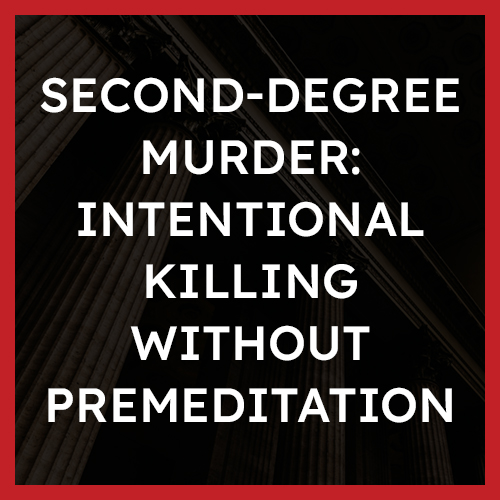Second-Degree Murder Laws: Intentional Killing without Premeditation
Introduction: What is Second-Degree Murder?

As per s. 229 of the Criminal Code, culpable homicide is murder when:
- One who causes a death, “means to cause that person’s death” regardless of whether or not death was the accused person’s intended outcome”
- One who causes a death “means to cause him bodily harm that he knows is likely to cause his death, and is reckless whether death ensues or not” regardless of whether death was the accused person’s intended outcome
- In carrying out a different unlawful act “does anything that they know is likely to cause death, and by doing so causes the death of a human being”, even if this is their unintended outcome.
Second-degree murder can be explained, in a sense, as the ‘default’ homicide charge. As per s. 231(7), “[a]ll murder that is not first-degree murder is second-degree murder”. Therefore, to elevate second-degree murder to first-degree murder, the Crown must show planning and deliberation (see our First-Degree Murder article here) . Murder is lessened to manslaughter when the intent of the offender is diminished. For example, where an offender perhaps didn’t intend for a fatal outcome, but it was reasonably foreseeable.
Sections 222, 229, 231 and 235 of the Criminal Code
Homicide
222 (1) A person commits homicide when, directly or indirectly, by any means, he causes the death of a human being.
Kinds of homicide
(2) Homicide is culpable or not culpable.
Non culpable homicide
(3) Homicide that is not culpable is not an offence.
Culpable homicide
(4) Culpable homicide is murder or manslaughter or infanticide.
(5) A person commits culpable homicide when he causes the death of a human being,
(a) by means of an unlawful act;
(b) by criminal negligence;
(c) by causing that human being, by threats or fear of violence or by deception, to do anything that causes his death; or
(d) by wilfully frightening that human being, in the case of a child or sick person.
Murder
229 Culpable homicide is murder
(a) where the person who causes the death of a human being
(i) means to cause his death, or
(ii) means to cause him bodily harm that he knows is likely to cause his death, and is reckless whether death ensues or not;
(b) where a person, meaning to cause death to a human being or meaning to cause him bodily harm that he knows is likely to cause his death, and being reckless whether death ensues or not, by accident or mistake causes death to another human being, notwithstanding that he does not mean to cause death or bodily harm to that human being; or
(c) if a person, for an unlawful object, does anything that they know is likely to cause death, and by doing so causes the death of a human being, even if they desire to effect their object without causing death or bodily harm to any human being.
Classification of murder
231 (1) Murder is first degree murder or second degree murder.
Planned and deliberate murder
(2) Murder is first degree murder when it is planned and deliberate.
Second degree murder
(7) All murder that is not first degree murder is second degree murder.
Punishment for murder
235 (1) Every one who commits first degree murder or second degree murder is guilty of an indictable offence and shall be sentenced to imprisonment for life.
Minimum punishment
(2) For the purposes of Part XXIII, the sentence of imprisonment for life prescribed by this section is a minimum punishment.
What is Needed to Convict a Person of Second-Degree Murder?
For the Crown to secure a conviction of second-degree murder, they must prove two main elements. At law, these are referred to as the actus reus and the mens rea. The actus reus requirements asks that the Crown prove that the actual act of murder in the second degree has been committed (i.e., the accused’s action caused the victim’s death). The mens rea requirements ask that the Crown prove the existence of intent to cause such death (often we ask “could the accused have foreseen the outcome?” when establishing intent (see: R v Vaillancourt, 1987 CanLII 2 (SCC), [1987] 2 SCR 636)).
The key element in demonstrating sufficient actus reus is showing “causation”. In other words, the accused must have caused the victim’s death. In determining whether the accused causes a death, the court will consider whether the accused’s act was a “significant contributing cause of death beyond something trifling or minor”. This test was established in the case R v Smithers, 1977 CanLII 7 (SCC); 1 SCR 506. To gauge the intent of an accused, the courts use a common-sense inference. If the reasonable person or sane/sober person acts in a way that has predictable consequences, then the trier of fact may infer that the person intended to cause those consequences (see: R v Seymour, 1996 CanLII 201 (SCC), [1996] 2 SCR 252).
What type of offence is second-degree murder?
Second-degree murder is what we refer to as a “straight indictable offence”. Straight indictable offences are relatively rare because they are reserved for the most serious types of Criminal Code offences. In Canadian criminal law, there are three classifications of criminal offences: indictable, summary and hybrid. Indictable offences are the more serious category of criminal offences and summary offences are the ‘less’ serious category of criminal offences. Hybrid offences are election-based meaning that the Crown will decide whether to proceed via indictment or as a summary charge after reviewing evidence. The Crown’s election relies on several factors such as whether the accused has a criminal record or history, the circumstances surrounding the offence, precedent, etc.
Examples
Acts which could constitute a second-degree murder charge can include:
- In following through on a plan to murder one individual, your plan is somewhat derailed because of the unexpected presence of another individual so you murder all those present (this would be one count first-degree [for the intended victim] and one count second-degree for the unanticipated victim]).
- In a heated argument with your neighbour, you impulsively grab a weapon and kill them
- You get into a physical fight with someone and deliver a blow which ultimately kills them.
- You leave someone to slowly die with a ligature around their neck.
Note that this is a non-exhaustive list.
Second-Degree Murder Defences
The availability and strength of any defence depends entirely on the specific facts of one’s case. However, the following are some frequently referenced or frequently asked-about defences that may be used when fighting a homicide charge:
Provocation
As per section 232 of the Criminal Code, even if the evidence establishes the actus reus and mens rea for murder, the defendant may be convicted of the lesser offence of manslaughter if there remains doubt that the defendant was provoked. As per section 232(2) of the Criminal Code,
[c]onduct of the victim that would constitute an indictable offence under this Act that is punishable by five or more years of imprisonment and that is of such a nature as to be sufficient to deprive an ordinary person of the power of self-control is provocation for the purposes of this section, if the accused acted on it on the sudden and before there was time for their passion to cool.
If the issue is raised, it is the duty of the Crown to prove that there was no provocation; it is not your responsibility to prove that there was provocation (see: R v Thibert, 1996 CanLII 249 (SCC), [1996] 1 SCR 37).
Intoxication
Intoxication is a very rare defence and has only been recently recognized as a defence for violent crimes by the Supreme Court of Canada (including murder). The law recognizes three types of intoxication (see: R v Daley, 2007 SCC 53 (CanLII), [2007] 3 SCR 523): mild, advanced, and extreme. Mild intoxication is not a defence. Advanced intoxication can be a partial defence and will demand of the court, that it consider whether the mens rea requirement is fully met. Extreme intoxication can be a complete defence to a charge of murder, however, as mentioned, this is incredibly rare. Extreme intoxication is said to be akin to automatism (see discussion about this directly below) and is then said to become a barrier to forming the requisite mental intent (mens rea) for being at fault for an offence.
Automatism
Again, automatism is a rare defence, but it is legally available. In R v Stone, 1999 CanLII 688 (SCC), [1999] 2 SCR 290, the Supreme Court of Canada defined automatism as “a state of impaired consciousness. The person engages in involuntary behaviour such that “a person who, though capable of action, is not conscious of what he is doing”. In simpler terms, as put in R v Rabey, 1977 CanLII 48 (ONCA), “it means an unconscious involuntary act where the mind does not go with what is being done”. There are two legally recognized types of automatism: that of which are brought on by a mental disorder and those acts which are not. Automatism affected by a mental disorder will flow into a finding of “not criminally responsible” (NCR). NCR findings are discussed in more detail here. Non-mental disorder automatism, where properly established, results in an acquittal of the charges (see: R v Alexander, 2015 BCCA 484 (CanLII)).
Self-defence
Self-defence is an available defence to a homicide charge. The defence is statutorily embedded in the Criminal Code under section 34.
Section 34(1) says that:
(1) A person is not guilty of an offence if
(a)they believe on reasonable grounds that force is being used against them or another person or that a threat of force is being made against them or another person;
(b)the act that constitutes the offence is committed for the purpose of defending or protecting themselves or the other person from that use or threat of force; and
(c)the act committed is reasonable in the circumstances.
Self-defence is a full justification for murder. It is to be considered in situations of “last resort” where a jury would accept that “the accused believed, on reasonable grounds, that his own safety and survival depended on killing the victim at that moment” (see: R v Cinous, 2002 SCC 29, [2002] 2 SCR 3).
Not Criminally Responsible (NCR)
Section 16 of the Criminal Code is intended to appreciate the existence of mental illness in the criminal context and “the principle of law that a person who suffers from a mental disorder which renders him incapable of making rational or autonomous choices should not be held criminally responsible” (see: R v Ejigu, 2016 BCSC 1487 (CanLII)). Section 16 of the Criminal Code reads that:
16 (1) No person is criminally responsible for an act committed or an omission made while suffering from a mental disorder that rendered the person incapable of appreciating the nature and quality of the act or omission or of knowing that it was wrong.
There is an automatic presumption at law that every person does not suffer from a mental disorder unless proven on a balance of probabilities (see: section 16(2) of the Criminal Code). A finding of NCR does lead to an acquittal for the offence. The court may still enforce a disposition, however, these are generally associated with the rehabilitation of the offender and are not necessarily sanction-based like conventional sentences for a criminal offence.
Applicable Charter Defences
The Canadian Charter sets out your rights and freedoms before and after your arrest. If the police fail to abide by these rights, either deliberately or inadvertently, it could aid in your defence. If any of your Charter rights have been violated before or after your arrest, you may be able to have some or all of the evidence that the Crown is relying on to secure a conviction excluded under s. 24(2) of the Charter.
Second-Degree Murder Punishment
A conviction of second-degree murder as prescribed by section 235(1) of the Criminal Code, results in an automatic life sentence. Parole ineligibility for second-degree murder is at least 10 years but up to 25 years (see: section 745.1(b) of the Criminal Code). If you are facing multiple murder charges these may be served “concurrently” or “consecutively”. A consecutive sentence means that if, for example, you were charged with three counts of second-degree murder, you could have to serve anywhere between 30 and 75 years in prison before parole eligibility. A concurrent sentence would permit the offender in the same scenario to still apply for parole after a flat 10-25 years (depending on the imposed parole eligibility) because concurrent sentences are served at the same time or on top of each other.
| Offence | Minimum Term of Imprisonment | Parole Eligibility |
| Murder in the second degree (adult) | Life (see: section 235(1)) | 1st conviction: 10–25 years. (see: sections 745(c) and 745.4)
2nd conviction: 25 years (see: section 745(b)) |
| Murder in the second degree (age 16-17 tried as an adult) | Life (see: section 745.1) | 7 years (see: section 745.1(c)) |
| Murder in the second degree (age 16> tried as an adult) | Life (see: section 745.1) | 5–7 years (see: sections 745.1(b) and 745.5) |
Additionally, after a conviction of second-degree murder, the court must: make an order for the taking of samples for the DNA databank: (see: section 487.051(1) of the Criminal Code); enforce a firearm prohibition in accordance with section 109 of the Criminal Code; and compel weapons used in the commission of the offence for forfeiture (see: section 491 of the Criminal Code). The court may also place bans on communicating with witnesses/victims and/or implement a victim surcharge fine.
Frequently Asked Questions
What is the difference between first and second-degree murder?
The key difference between first-degree murder and second-degree murder is the existence of premeditation. Both categories of murder require proof that the accused intended death as an outcome, however, first-degree murder carries an extra element of proof that such murder was planned and deliberate. Where there is no planning or deliberation, but the accused still intended to kill the victim, the accused may be found guilty of second-degree murder. Additionally, the punishments for both are also somewhat different. While both first-degree murder and second-degree murder carry life sentences, parole eligibility differs depending on the degree. For first-degree murder, parole eligibility is set at 25 years and for second-degree murder, parole eligibility can be set anywhere between 10-25 years.
What is the penalty for second-degree murder in Canada?
A conviction of second-degree murder as prescribed by section 235(1) of the Criminal Code, results in an automatic life sentence. Parole ineligibility for second-degree murder is at least 10 years but up to 25 years (see: section 745.1(b) of the Criminal Code). For more information, see our “Second-Degree Murder Punishment” heading here.
How many years is a life sentence in Canada?
As its wording indicates, a life sentence in Canada is in place for the offender’s lifetime. Parole eligibility is generally the only factor which may veto this disposition. When an offender gets out on parole, they are no longer incarcerated, however, may be required to abide by conditions while existing in the community again. Parole is not promised or guaranteed to anyone charged with murder and therefore, an offender is liable to spend his/her entire mortal life after conviction, imprisoned.
Published Decisions
R v McKenna, 2015 SCC 63 (CanLII), [2015] 3 SCR 1087
The accused (Mr. McKenna) and the victim had done some contracted renovations together. After the victim was paid for the total of the completed work, the accused learned that he never received his cut (totalling $15,000). After a day of heavy drinking, Mr. McKenna loaded a shotgun and attended the residence of the victim to obtain the victim’s banking information so that he could withdraw money from his account. The accused claimed that he only intended to intimidate the victim but that the victim grabbed the shotgun and it discharged accidentally, causing the victim’s death. He was then convicted of second-degree murder. On appeal, the accused argued that it was incumbent upon the trial judge to mention what the term manslaughter meant and therefore, the Court of Appeal found that the failure of the trial judge to properly instruct the jury constituted a misdirection and a new trial was ordered. The Crown appealed this decision, however, the Supreme Court of Canada dismissed the appeal noting that the errors of law in connection with the trial judge’s failure to identify the unlawful act and to properly instruct the jury on the elements of manslaughter prejudiced the accused.
For a read of the full case, the New Brunswick Court of Appeal case is linked here; noting that the Supreme Court of Canada did not offer a detailed written decision (linked here).
R v Walle, 2012 SCC 41 (CanLII), [2012] 2 SCR 438
Mr. Walle shot the victim with a rifle at close range, killing him and was convicted of second-degree murder. At trial, the judge rejected the accused’s evidence that the discharge of the gun was unintentional as not credible and, applying “common sense inference,” (the common sense inference is discussed in this article here) concluded that the accused had the requisite intent for second-degree murder. The accused’s appeal to both the provincial court of appeal and the Supreme Court of Canada (SCC) was dismissed. The SCC explained that the trial judge did not err in resorting to “common sense inference” and that there was no failure to consider all relevant. The SCC found that the “common sense inference” can have a role to play even in cases where the accused is impaired.
You can read the full case here.
R v Nette, 2001 SCC 78 (CanLII), [2001] 3 SCR 488
A 95-year-old widow was robbed and left hog-tied in her room with a ligature around her neck. Over a period of 48 hours, she suffocated to death. During an undercover investigation, a suspect, Mr. Nette, admitted to an undercover officer that he had robbed and killed the widow.
Mr. Nette was arrested and charged with first-degree murder under section 231(5) of the Criminal Code, however, at trial, he was convicted of second-degree murder by a jury. This case was appealed to the Supreme Court of Canada because it was argued that the charge to the jury on the principles of causation (i.e., did the acts of the accused cause the victim’s death) was erroneous. The Supreme Court of Canada agreed that the principles of causation we improperly explained to the jury and the Supreme Court of Canada reaffirmed the Smithers Test for challenging causation in second-degree murder cases. See the test here. The accused was ultimately found guilty of second-degree murder.
You can read the full case here.
About The Author







